| Listing 1 - 7 of 7 |
Sort by
|
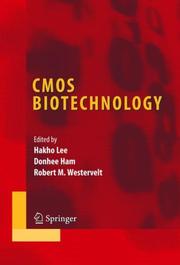
ISBN: 1280865369 9786610865369 0387689133 0387368361 Year: 2007 Publisher: New York : Springer,
Abstract | Keywords | Export | Availability | Bookmark
 Loading...
Loading...Choose an application
- Reference Manager
- EndNote
- RefWorks (Direct export to RefWorks)
CMOS Biotechnology reviews the recent research and developments joining CMOS technology with biology. Written by leading researchers these chapters delve into four areas including: Microfluidics for electrical engineers CMOS Actuators CMOS Electrical Sensors CMOS Optical Sensors Bioanalytical instruments have been miniaturized on ICs to study various biophenomena or to actuate biosystems. These bio-lab-on-IC systems utilize the IC to facilitate faster, repeatable, and standardized biological experiments at low cost with a small volume of biological sample. CMOS Biotechnology will interest electrical engineers, bioengineers, biophysicists as well as researchers in MEMS, bioMEMS, microelectronics, microfluidics, and circuits and systems.
Metal oxide semiconductors, Complementary. --- Biochips. --- Bioreactors --- Molecular computers --- Combinatorial chemistry --- CMOS (Electronics) --- Complementary metal oxide semiconductors --- Semiconductors, Complementary metal oxide --- Digital electronics --- Logic circuits --- Transistor-transistor logic circuits
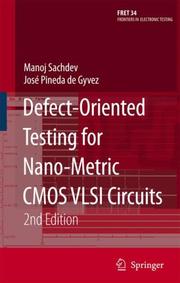
ISBN: 1280938218 9786610938216 0387465472 0387465464 1441942858 Year: 2007 Publisher: Dordrecht : Springer,
Abstract | Keywords | Export | Availability | Bookmark
 Loading...
Loading...Choose an application
- Reference Manager
- EndNote
- RefWorks (Direct export to RefWorks)
Failures of nano-metric technologies owing to defects and shrinking process tolerances give rise to significant challenges for IC testing. As the variation of fundamental parameters such as channel length, threshold voltage, thin oxide thickness and interconnect dimensions goes well beyond acceptable limits, new test methodologies and a deeper insight into the physics of defect-fault mappings are needed. In Defect-Oriented Testing for Nano-Metric CMOS VLSI Circuits state of the art of defect-oriented testing is presented from both a theoretical approach as well as from a practical point of view. Step-by-step handling of defect modeling, defect-oriented testing, yield modeling and its usage in common economics practices enables deeper understanding of concepts. The progression developed in this book is essential to understand new test methodologies, algorithms and industrial practices. Without the insight into the physics of nano-metric technologies, it would be hard to develop system-level test strategies that yield a high IC fault coverage. Obviously, the work on defect-oriented testing presented in the book is not final, and it is an evolving field with interesting challenges imposed by the ever-changing nature of nano-metric technologies. Test and design practitioners from academia and industry will find that Defect-Oriented Testing for Nano-Metric CMOS VLSI Circuits lays the foundations for further pioneering work.
Integrated circuits --- Metal oxide semiconductors, Complementary --- Very large scale integration --- Defects. --- Testing. --- CMOS (Electronics) --- Complementary metal oxide semiconductors --- Semiconductors, Complementary metal oxide --- Digital electronics --- Logic circuits --- Transistor-transistor logic circuits --- Chips (Electronics) --- Circuits, Integrated --- Computer chips --- Microchips --- Electronic circuits --- Microelectronics --- Systems engineering. --- Computer engineering. --- Engineering design. --- Electronics. --- Circuits and Systems. --- Electrical Engineering. --- Engineering Design. --- Electronics and Microelectronics, Instrumentation. --- Electrical engineering --- Physical sciences --- Design, Engineering --- Engineering --- Industrial design --- Strains and stresses --- Computers --- Engineering systems --- System engineering --- Industrial engineering --- System analysis --- Design --- Design and construction --- Electronic circuits. --- Electrical engineering. --- Microelectronics. --- Microminiature electronic equipment --- Microminiaturization (Electronics) --- Electronics --- Microtechnology --- Semiconductors --- Miniature electronic equipment --- Electric engineering --- Electron-tube circuits --- Electric circuits --- Electron tubes

ISBN: 1280724722 9786610724727 140205081X 1402050801 9781402050800 Year: 2007 Publisher: Berlin ; [London] : Springer,
Abstract | Keywords | Export | Availability | Bookmark
 Loading...
Loading...Choose an application
- Reference Manager
- EndNote
- RefWorks (Direct export to RefWorks)
In the deep sub-micron regime, the power consumption has become one of the most important issues for competitive design of digital circuits. Due to dramatically increasing leakage currents, the power consumption does not take advantage of technology scaling as before. State-of-art power reduction techniques like the use of multiple supply and threshold voltages, transistor stack forcing and power gating are discussed with respect to implementation and power saving capability. Focus is given especially on technology dependencies, process variations and technology scaling. Design and implementation issues are discussed with respect to the trade-off between power reduction, performance degradation, and system level constraints. A complete top-down design flow is demonstrated for power gating techniques introducing new design methodologies for the switch sizing task and circuit blocks for data-retention and block activation. The leakage reduction ratio and the minimum power-down time are introduced as figures of merit to describe the power gating technique on system level and give a relation to physical circuit parameters. Power Management of Digital Circuits in Deep Sub-Micron CMOS Technologies mainly deals with circuit design but also addresses the interface between circuit and system level design on the one side and between circuit and physical design on the other side.
Digital integrated circuits --- Integrated circuits --- Electric circuit analysis. --- Digital electronics. --- Electric power supplies to apparatus. --- Metal oxide semiconductors. --- Design and construction. --- Ultra large scale integration. --- Unipolar transistors --- Semiconductors --- Transistors --- Charge coupled devices --- Power supplies to apparatus, Electric --- Electric power --- Digital circuits --- Digital techniques (Electronics) --- Electronic systems --- Electronics --- Circuit analysis, Electric --- Electric circuits --- Electric network analysis --- ULSI circuits --- Ultra large scale integration of circuits --- Digital electronics --- Metal oxide semiconductors, Complementary --- CMOS (Electronics) --- Complementary metal oxide semiconductors --- Semiconductors, Complementary metal oxide --- Logic circuits --- Transistor-transistor logic circuits --- Electrical engineering
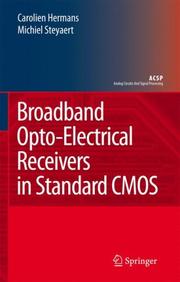
ISBN: 1280937491 9786610937493 1402062222 1402062214 9048175720 Year: 2007 Publisher: Dordrecht : Springer Verlag,
Abstract | Keywords | Export | Availability | Bookmark
 Loading...
Loading...Choose an application
- Reference Manager
- EndNote
- RefWorks (Direct export to RefWorks)
Broadband Opto-Electrical Receivers in Standard CMOS fits in the quest for integrated opto-electrical solutions, and focuses on the receiver front-end. To further reduce the cost, the cheapest technology is selected: standard CMOS, without any optical tricks or flavors. The emphasis is on the analysis, design and implementation of high-performance analog receiver circuits. Broadband Opto-Electrical Receivers in Standard CMOS starts from the basic fundamentals, necessary for the design of opto-electronic interface circuits. The book continues with an in-depth analysis of the photodiode, transimpedance amplifier (TIA) and limiting amplifier (LA). To thoroughly understand the light detection mechanisms in silicon, first a one-dimensional and second a two-dimensional model is developed. Analytical design equations are derived to guide the design of the amplifying circuits. For the TIA, the focus lies on the sensitivity-speed trade-off. For the LA, a high gain-bandwidth is pursued. Several practical design examples reveal the subtleties and challenges encountered during the design of high-performance analog circuits. Broadband Opto-Electrical Receivers in Standard CMOS covers the total design flow of monolithic CMOS optical receivers. All material is experimentally verified with several CMOS implementations, with ultimately a fully integrated Gbit/s optical receiver front-end including photodiode, TIA and LA. The book is essential reading for analog design engineers and researchers in the field and is also suitable as a text book for an advanced course on the subject.
Photodiodes. --- Optical amplifiers. --- Metal oxide semiconductors, Complementary. --- Amplifiers, Optical --- Light amplifiers --- Optoelectronic devices --- Photoconductor diodes --- Diodes, Semiconductor --- Optical detectors --- CMOS (Electronics) --- Complementary metal oxide semiconductors --- Semiconductors, Complementary metal oxide --- Digital electronics --- Logic circuits --- Transistor-transistor logic circuits --- Systems engineering. --- Electronics. --- Circuits and Systems. --- Electronics and Microelectronics, Instrumentation. --- Optics, Lasers, Photonics, Optical Devices. --- Electrical engineering --- Physical sciences --- Engineering systems --- System engineering --- Engineering --- Industrial engineering --- System analysis --- Design and construction --- Electronic circuits. --- Microelectronics. --- Lasers. --- Photonics. --- New optics --- Optics --- Light amplification by stimulated emission of radiation --- Masers, Optical --- Optical masers --- Light sources --- Nonlinear optics --- Optical parametric oscillators --- Microminiature electronic equipment --- Microminiaturization (Electronics) --- Electronics --- Microtechnology --- Semiconductors --- Miniature electronic equipment --- Electron-tube circuits --- Electric circuits --- Electron tubes
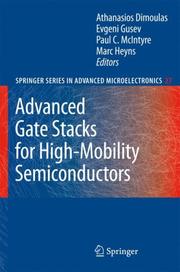
ISBN: 1281179302 9786611179304 354071491X 3540714901 3642090710 9783540714903 Year: 2007 Publisher: Berlin : Springer,
Abstract | Keywords | Export | Availability | Bookmark
 Loading...
Loading...Choose an application
- Reference Manager
- EndNote
- RefWorks (Direct export to RefWorks)
Will nanoelectronic devices continue to scale according to Moore’s law? At this moment, there is no easy answer since gate scaling is rapidly emerging as a serious roadblock for the evolution of CMOS technology. Channel engineering based on high-mobility semiconductor materials (e.g. strained Si, alternative orientation substrates, Ge or III-V compounds) could help overcome the obstacles since they offer performance enhancement. There are several concerns though. Do we know how to make complex engineered substrates (e.g. Germanium-on-Insulator)? Which are the best interface passivation methodologies and (high-k) gate dielectrics on Ge and III-V compounds? Can we process these materials in short channel transistors using flows, toolsets and know how similar to that in Si technology? How do these materials and devices behave at the nanoscale? The reader will get a clear view of what has been done so far, what is the state-of-the-art and which are the main challenges ahead before we come any close to a viable Ge and III-V MOS technology.
Engineering. --- Electronics. --- Microelectronics. --- Electronics and Microelectronics, Instrumentation. --- Microminiature electronic equipment --- Microminiaturization (Electronics) --- Electronics --- Microtechnology --- Semiconductors --- Miniature electronic equipment --- Electrical engineering --- Physical sciences --- Construction --- Industrial arts --- Technology --- Gate array circuits --- Metal oxide semiconductors. --- Metal oxide semiconductors, Complementary. --- Dielectrics. --- Germanium compounds. --- Materials. --- Gate arrays --- Integrated circuits --- Chemicals --- Electric insulators and insulation --- CMOS (Electronics) --- Complementary metal oxide semiconductors --- Semiconductors, Complementary metal oxide --- Digital electronics --- Logic circuits --- Transistor-transistor logic circuits --- Unipolar transistors --- Transistors --- Charge coupled devices --- Materials --- Dielectrics --- Germanium compounds --- Metal oxide semiconductors --- Metal oxide semiconductors, Complementary --- 621.3.049.77 --- 621.3.049.77 Microelectronics. Integrated circuits --- Microelectronics. Integrated circuits
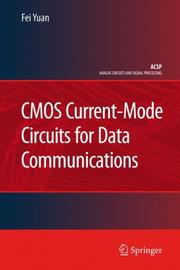
ISBN: 1280852445 9786610852444 0387476911 0387297588 1441939997 Year: 2007 Publisher: New York : Springer,
Abstract | Keywords | Export | Availability | Bookmark
 Loading...
Loading...Choose an application
- Reference Manager
- EndNote
- RefWorks (Direct export to RefWorks)
This book addresses the analysis and design principles of CMOS current mode circuits and their applications for data communications. The analytical methods and design principles are based on the characteristics of MOS devices applied to current CMOS technologies. Major topics include: design techniques for current mode circuits, electrical signaling for high speed data links, current-mode transmitters and receivers, switching noise and grounding of mixed mode circuits, a comparison of voltage-mode with current-mode circuits, ESD protection, and additional related topics. Examples are given of CMOS technologies from leading semiconductor companies and analyzed using the latest computer-aided design tools by leading design companies. CMOS Current-Mode Circuits for Data Communications is a valuable reference for circuit design engineers and hardware system engineers.
Metal oxide semiconductors, Complementary. --- Integrated circuits. --- Chips (Electronics) --- Circuits, Integrated --- Computer chips --- Microchips --- Electronic circuits --- Microelectronics --- CMOS (Electronics) --- Complementary metal oxide semiconductors --- Semiconductors, Complementary metal oxide --- Digital electronics --- Logic circuits --- Transistor-transistor logic circuits --- Systems engineering. --- Electronics. --- Computer aided design. --- Computer hardware. --- Computer engineering. --- Circuits and Systems. --- Electronics and Microelectronics, Instrumentation. --- Computer-Aided Engineering (CAD, CAE) and Design. --- Computer Hardware. --- Electrical Engineering. --- Computers --- CAD (Computer-aided design) --- Computer-assisted design --- Computer-aided engineering --- Design --- Electrical engineering --- Physical sciences --- Engineering systems --- System engineering --- Engineering --- Industrial engineering --- System analysis --- Design and construction --- Electronic circuits. --- Microelectronics. --- Computer-aided engineering. --- Electrical engineering. --- Electric engineering --- CAE --- Microminiature electronic equipment --- Microminiaturization (Electronics) --- Electronics --- Microtechnology --- Semiconductors --- Miniature electronic equipment --- Electron-tube circuits --- Electric circuits --- Electron tubes --- Data processing
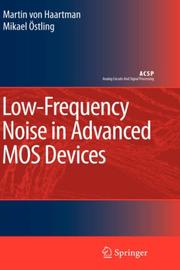
ISBN: 128110275X 9786611102753 1402059108 1402059094 9048174724 Year: 2007 Publisher: Dordrecht : Springer,
Abstract | Keywords | Export | Availability | Bookmark
 Loading...
Loading...Choose an application
- Reference Manager
- EndNote
- RefWorks (Direct export to RefWorks)
Low-Frequency Noise in Advanced CMOS Devices begins with an introduction to noise, describing the fundamental noise sources and basic circuit analysis. The characterization of low-frequency noise is discussed in detail and useful practical advice is given. The various theoretical and compact low-frequency (1/f) noise models in MOS transistors are treated extensively providing an in-depth understanding of the low-frequency noise mechanisms and the potential sources of the noise in MOS transistors. Advanced CMOS technology including nanometer scaled devices, strained Si, SiGe, SOI, high-k gate dielectrics, multiple gates and metal gates are discussed from a low-frequency noise point of view. Some of the most recent publications and conference presentations are included in order to give the very latest view on the topics. The book ends with an introduction to noise in analog/RF circuits and describes how the low-frequency noise can affect these circuits.
Electronic noise. --- Metal oxide semiconductor field-effect transistors. --- Metal oxide semiconductors, Complementary. --- MOSFET --- Field-effect transistors --- Metal oxide semiconductors --- Noise, Electronic --- Signal theory (Telecommunication) --- Electric noise --- CMOS (Electronics) --- Complementary metal oxide semiconductors --- Semiconductors, Complementary metal oxide --- Digital electronics --- Logic circuits --- Transistor-transistor logic circuits --- Electronics. --- Systems engineering. --- Acoustics. --- Engineering. --- Microwaves. --- Electronics and Microelectronics, Instrumentation. --- Circuits and Systems. --- Engineering, general. --- Microwaves, RF and Optical Engineering. --- Construction --- Industrial arts --- Technology --- Engineering systems --- System engineering --- Engineering --- Industrial engineering --- System analysis --- Electrical engineering --- Physical sciences --- Hertzian waves --- Electric waves --- Electromagnetic waves --- Geomagnetic micropulsations --- Radio waves --- Shortwave radio --- Design and construction --- Microelectronics. --- Electronic circuits. --- Optical engineering. --- Mechanical engineering --- Electron-tube circuits --- Electric circuits --- Electron tubes --- Electronics --- Microminiature electronic equipment --- Microminiaturization (Electronics) --- Microtechnology --- Semiconductors --- Miniature electronic equipment
| Listing 1 - 7 of 7 |
Sort by
|

 Search
Search Feedback
Feedback About UniCat
About UniCat  Help
Help News
News